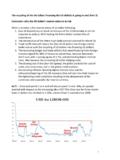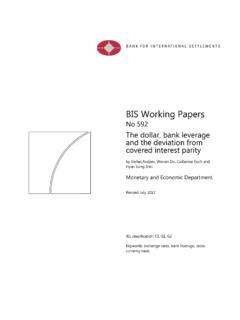Transcription of Interest Rate Models - LMU München
1 Interest Rate ModelsDamir Filipovi cUniversity of Munich2 Contents1 Introduction72 Interest rates and Related Zero-Coupon Bonds .. Interest rates .. Market Example: LIBOR .. Simple vs. Continuous Compounding .. Forward vs. Future rates .. Bank Account and Short rates .. Coupon Bonds, Swaps and Yields .. Fixed Coupon Bonds .. Floating Rate Notes .. Interest Rate Swaps .. Yield and Duration .. Market Conventions .. Day-count Conventions .. Coupon Bonds .. Accrued Interest , Clean Price and Dirty Price .. Yield-to-Maturity .. Caps and Floors .. Swaptions .. 293 Statistics of the Yield Principal Component Analysis (PCA) .. PCA of the Yield Curve.
2 Correlation .. 3634 CONTENTS4 Estimating the Yield A Bootstrapping Example .. General Case .. Bond Markets .. Money Markets .. Problems .. Parametrized Curve Families .. 495 Why Yield Curve Models ?656 Arbitrage Self-Financing Portfolios .. Arbitrage and Martingale Measures .. Hedging and Pricing .. 737 Short Rate Generalities .. Diffusion Short Rate Models .. Examples .. Inverting the Yield Curve .. Affine Term Structures .. Some Standard Models .. Vasicek model .. Cox Ingersoll Ross model .. Dothan model .. Ho Lee model .. Hull White model .. Option Pricing in Affine Models .. Example: Vasicek model (a,b, const, = 0).
3 928 HJM Methodology959 Forward as Numeraire .. An Expectation Hypothesis .. Option Pricing in Gaussian HJM Models .. 101 CONTENTS510 Forwards and Forward Contracts .. Futures Contracts .. Interest Rate Futures .. Forward vs. Futures in a Gaussian Setup .. 10911 Multi-Factor No-Arbitrage Condition .. Affine Term Structures .. Polynomial Term Structures .. Exponential-Polynomial Families .. Nelson Siegel Family .. Svensson Family .. 12312 Market Models of Forward LIBOR rates .. Discrete-tenor Case .. Continuous-tenor Case .. 14013 Default Transition and Default Probabilities .. Historical Method .. Structural Approach .. Intensity Based Method .. Construction of Intensity Based Models .
4 Computation of Default Probabilities .. Pricing Default Risk .. Measure Change .. 1606 CONTENTSC hapter 1 IntroductionThese notes have been written for a graduate course on fixed income modelsthat I held in the fall term 2002 2003 at the Department of Operations Re-search and Financial Engineering at Princeton number of books on fixed income Models is growing, yet it is difficultto find a convenient textbook for a one-semester course like this. There areseveral reasons for this: Until recently, many textbooks on mathematical finance have treatedstochastic Interest rates as an appendix to the elementary arbitragepricing theory, which usually requires constant (zero) Interest rates . Interest rate theory is not standardized yet: there is no well-accepted standard general model such as the Black Scholes model for equities.
5 The very nature of fixed income instruments causes difficulties, otherthan for stock derivatives, in implementing and calibrating issues should therefore not been left will frequently refer to the following books:B[3]:Bj ork (98) [3]. A pedagogically well written introductionto mathe-matical finance. Chapters 15 20 are on Interest [6]:Brigo Mercurio (01) [6]. This is a book on Interest rate modellingwritten by two quantitative analysts in financial is on the practical implementation and calibrationof 1. INTRODUCTIONJW[12]:James Webber (00) [12]. An encyclopedic treatment of interestrates and their related financial [14]:Jarrow (96) [14]. Introduction to fixed-income securities andinterestrate options.
6 Discrete time [20]:Musiela Rutkowski (97) [20]. A comprehensive book on financialmathematics with a large part (Part II) on Interest rate emphasis is on market pricing [23]:Rebonato (98) [23]. Written by a practitionar. Much emphasisonmarket practice for pricing and handling Interest rate [28]:Zagst (02) [28]. A comprehensive textbook on mathematical finance, Interest rate modelling and risk this text had been written, new good books on Interest rates havebeen published. I want to mention in particular the excellentintroductorytextbook by Cairns (04) [7].I did not intend to write an entire text but rather collect fragments of thematerial that can be found in the above books and further , October 2005 Chapter 2 Interest rates and RelatedContractsLiterature: B[3](Chapter 15), BM[6](Chapter 1), and many Zero-Coupon BondsA dollar today is worth more than a dollar tomorrow.
7 The timetvalue ofa dollar at timeT tis expressed by thezero-coupon bondwithmaturityT,P(t, T), for briefty alsoT-bond. This is a contract which guarantees theholder one dollar to be paid at the maturity (t,T)t||T future cashflows can be discounted, such as coupon-bearing bondsC1P(t, t1) + +Cn 1P(t, tn 1) + (1 +Cn)P(t, T).In theory we will assume that there exists a frictionless market forT-bonds for everyT >0. P(T, T) = 1 for allT. P(t, T) is continuously differentiable 2. Interest rates AND RELATED CONTRACTSIn reality this assumptions are not always satisfied: zero-couponbonds arenot traded for all maturities, andP(T, T) might be less than one if the issuerof theT-bond defaults. Yet, this is a good starting point for doing themathematics.
8 More realistic Models will be introduced and discussed in third condition is purely technical and implies that theterm structureof zero-coupon bond pricesT7 P(t, T) is a smooth Treasury Bonds, March 2002 Note thatt7 P(t, T) is a stochastic process since bond pricesP(t, T) arenot known with certainty ,10LA reasonable assumption would also be thatT7 P(t, T) 1 is a de-creasing curve (which is equivalent to positivity of Interest rates ). However,already classical Interest rate Models imply zero-coupon bondprices greaterthan 1. Therefore we leave away this Interest Interest RatesThe term structure of zero-coupon bond prices does not contain much visualinformation (strictly speaking it does). A better measure is given by theimplied Interest rates .
9 There is a variety of prototypicalforward rate agreement (FRA)is a contract involving threetime instantst < T < S: the current timet, the expiry timeT > t, and thematurity timeS > T. Att: sell oneT-bond and buyP(t,T)P(t,S)S-bonds = zero net investment. AtT: pay one dollar. AtS: obtainP(t,T)P(t,S) net effect is a forward investment of one dollar at timeTyieldingP(t,T)P(t,S)dollars atSwith are led to the following definitions. Thesimple (simply-compounded) forward ratefor [T, S] prevailing attis given by1+(S T)F(t;T, S) :=P(t, T)P(t, S) F(t;T, S) =1S T(P(t, T)P(t, S) 1). Thesimple spot ratefor [t, T] isF(t, T) :=F(t;t, T) =1T t(1P(t, T) 1). Thecontinuously compounded forward ratefor [T, S] prevailing attisgiven byeR(t;T,S)(S T):=P(t, T)P(t, S) R(t;T, S) = logP(t, S) logP(t, T)S T.
10 Thecontinuously compounded spot ratefor [T, S] isR(t, T) :=R(t;t, T) = logP(t, T)T 2. Interest rates AND RELATED CONTRACTS Theinstantaneous forward ratewith maturityTprevailing at timetisdefined byf(t, T) := limS TR(t;T, S) = logP(t, T) T.( )The functionT7 f(t, T) is called theforward curveat timet. Theinstantaneous short rateat timetis defined byr(t) :=f(t, t) = limT tR(t, T).Notice that ( ) together with the requirementP(T, T) = 1 is equivalent toP(t, T) = exp( Ttf(t, u)du). Market Example: LIBOR Interbank rates are rates at which deposits between banks are exchanged,and at which swap transactions (see below) between banks mostimportant interbank rate usually considered as a reference for fixed incomecontracts is theLIBOR (London InterBank Offered Rate)1for a series ofpossible maturities, ranging fromovernightto 12 months.






